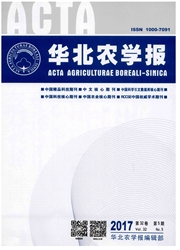

 中文摘要:
中文摘要:
为明确甘蓝型油菜花叶性状的遗传特点,开发与花叶性状连锁的分子标记。以甘蓝型油菜品系2205(圆叶)、1423(花叶)为亲本,构建了3个世代群体:F1、BC1和F2,探讨花叶性状的遗传规律;利用分子标记技术对花叶基因进行定位。结果表明,F1植株叶形表现为花叶,BC1(F1×2205)和F2中花叶与圆叶的植株分离比分别符合1∶1和3∶1,说明甘蓝型油菜的花叶性状受1对不完全显性基因控制。利用集团分离法(BSA)筛选637对SSR引物,共筛选到了3个与花叶基因紧密连锁的SSR标记:CB10079、BNGMS114和BNGMS385。连锁分析发现,这3个连锁标记均位于花叶基因的一侧,其中BNGMS114与花叶基因的遗传距离最近,其遗传距离为2.5 c M。将这3个连锁标记的序列与白菜基因组的序列进行比对,结果发现它们与白菜A10染色体的序列共线性较好,花叶基因位于A10染色体的15.70 Mb下游区段。上述标记的获得为油菜花叶性状的分子标记辅助选择育种以及花叶基因的克隆奠定理论基础。
 英文摘要:
英文摘要:
In order to study the genetic characteristic of mosaic-leaf and identify the molecular markers linked to mosaic-leaf in Brassica napus L.. In this study,three segregated populations,F1,BC1 and F2,were constructed by crossing two parent lines,2205( round-leaf) and 1423( mosaic-leaf). The mosaic-leaf line of two parents and the segregated populations were used to analyze the inheritance of mosaic-leaf; molecular marker technology was used to map the mosaic-leaf gene. The results showed that the leaf morphology of F1 plants revealed mosaic-leaf phenotype and the separated proportion of mosaic-leaf to round leaf in BC1( F1× 2205) and F2 was fitted to 1 ∶ 1 and 3 ∶ 1,respectively,which showed that the mosaic leaf was controlled by a pair of incomplete dominant gene. Meanwhile,637 pairs of SSR primers combined with bulked segregation analysis( BSA) were employed to identify the markers linked to mosaic-leaf gene. As a result,three markers: CB10079,BNGMS114 and BNGMS385,linked to the mosaicleaf gene were identified. All of them were located in one side of the gene,and BNGMS114 was closest to the gene with a distance of 2. 5 c M. The sequences of three markers were submitted to blast with those of B. rapa genome.The results indicated that the sequences of three markers showed good collinearity with those of A10 chromosome.The target gene was located in the downstream section of 15. 70 Mb on A10. These results will be useful for MAS and the mosaic-leaf gene cloning.
 同期刊论文项目
同期刊论文项目
 同项目期刊论文
同项目期刊论文
 期刊信息
期刊信息
